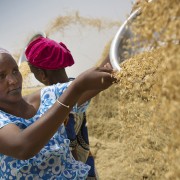USAID is committed to helping Ethiopia leverage its human and economic capital, and to harness the power of Ethiopian farms and entrepreneurs to create a more economically prosperous and food-secure Ethiopia. This is why, yesterday, I announced that Ethiopia will be a target country for the next phase of Feed the Future. We look forward to partnering with Ethiopia on Feed the Future venture.
USAID Administrator Mark Green met today with Prime Minister Hailemariam Desalegn of the Federal Democratic Republic of Ethiopia. Administrator Green and Prime Minister Desalegn discussed U.S. support for Ethiopia's economic development, drought response, and food security.

Yesterday, U.S. Agency for International Development (USAID) Administrator Mark Green announced the selection of 12 target countries for the next phase in America's global hunger and food security initiative, Feed the Future: Bangladesh, Ethiopia, Ghana, Guatemala, Honduras, Kenya, Mali, Nepal, Niger, Nigeria, Senegal, and Uganda.
Feed the Future harnesses the power of American development leadership and innovation to partner with host governments, and community leaders and the private sector to build resilient communities with the goal of helping people stand on their own two feet, no matter what challenge may come their way. By equipping people with the tools to feed themselves and their families over the long term, Feed the Future and our partners are addressing the root causes of hunger and poverty and bolstering their ability to meet future challenges. Ethiopia, in particular, is a great example of the impact that the Feed the Future partnership can have. Thanks to all of you and your hard work, Ethiopia is making strong progress. Because of investments by the national government, and with the support of smart development assistance, Ethiopia was able to bounce back from 2015 and 2016 droughts. And I'm confident that Ethiopia's resilience will help the country to weather the current drought as well.
I think Feed the Future itself, as an approach, is not simply humanitarian response. Humanitarian response is important, but we’re all understanding, you want to help people protect themselves and to be strengthened against the potential for future shock and crisis, as a sad reality, Ethiopia seems to get those shocks every few years; not just once a generation. And so, I think what we’re doing here, these sorts of facilities which create better livelihoods, but also some of the partnership for putting together, including the American business community, agribusiness community is a very smart way of tackling food and security.







Comment
Make a general inquiry or suggest an improvement.